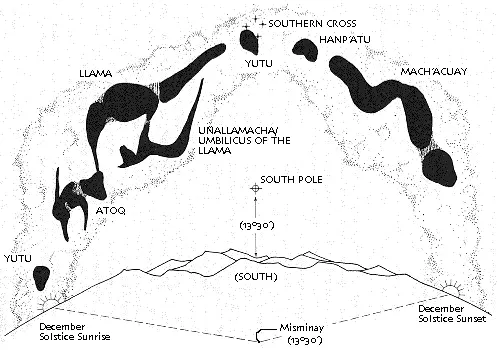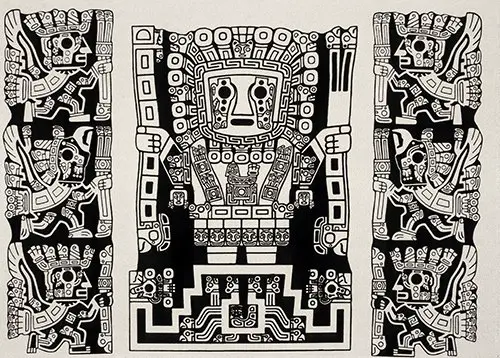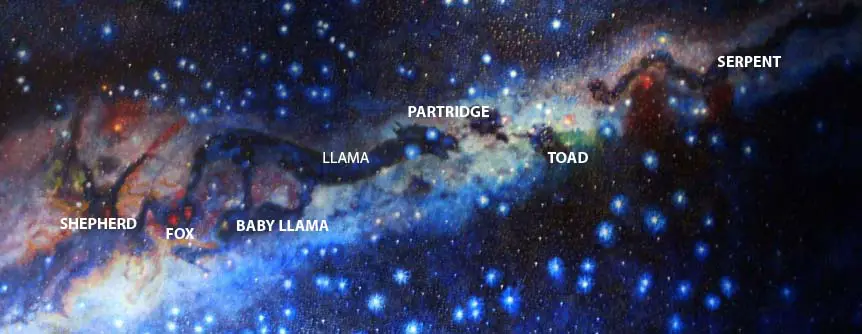This article is based on the summary of William Sullivan's book "The Mystery of the Incas" edited by Piervittorio Formichetti and expanded by Marco Maculotti.
waka, totem animals, constellations
The ancient Andean peoples called huaca (o waka) "the presence of the sacred and the magical-telluric in each of its multiple forms or manifestations (stones, mountains, rivers, stars, celestial and terrestrial phenomena, crossroads, funeral cults, etc.)"That they encountered everywhere in a sacred world / mental space [González, The pre-Columbian symbols, p. 75]. In other words, they revered the innumerable states of a Universal Being manifesting through the environment as a hierophany. The Italian anthropologist Mario Polia writes [The blood of the condor, p. 86], reporting an indigenous tradition of the Samanga valley: "Le huacas, be they rocks, stones or mountains, they are hungry and if men do not nourish them, they devour their soul, their "shadow", sucking life from their bodies. If they are satisfied, however, they protect the fields, ward off evils and call the rains».
William Sullivan, in his book The mystery of the Incas which we will focus on here, states that with the term waka the Andean peoples and the Incas intended to indicate, among other things, also the totem animal, the ancestor, the progenitor, the progenitor of a people. The animal waka it was also a stellar animal, traceable in a constellation or in a dark area of 'empty' sky between the constellations, seen as a silhouette similar to the shape of the animal, for example. the Lama (Calls).
I waka 'stellar', rising and falling above or below the plane of the galaxy (Milky Way) or the ecliptic, indicated the destiny of the people of which they were tutelary deities / ancestors. The highest point reached by the waka in this 'roller coaster' trip it was said by analogy "mountain"And the lower one was said"sea","place of the shells»Or«conch shell»: The ancient Andean civilizations therefore used terrestrial and marine terms to indicate astronomical phenomena and celestial points of reference to which enormous importance was given for the life of the community.
With all this, Sullivan refers to the theory of Giorgio de Santillana and Hertha von Dechend in Il Hamlet's mill, for which:
- mythical animals (huaca) are constellations or 'shapes' of darkness between constellations ("dark constellations");
- even the planets are gods / tutelary gods /waka;
- spatial references to terrestrial places seem to indicate places on earth or sea, but in reality they indicate sidereal positions of stars, constellations or dark areas between one constellation and another (planets / animals-totems /waka) [cf. Stellar symbolism and solar symbolism].
To better understand this concept it is necessary to quote what Fernando and Edgar Elorrieta Salazar note [Cusco and the sacred valley of the Incas, p. 66]: «yestabilitated by religious tradition that beings on Earth each had a common ancestor in the stars", The ancient inhabitants of South America identified these mythical ancestors in the celestial vault and"taking the Milky Way as the main reference plane for observing the sky, they conjugated [...] some stars with dark clouds appearing along its trajectory to form the so-called "black constellations" [or, as we have seen, dark areas of 'empty' sky between the constellations, ed], among which we can recognize the lama, the toad, the partridge, the fox and the snake - pcelestial rototypes on which it was thought that the multiplication and well-being of these species depended».

It is also said that "similarly, in the communities of shepherds and farmers who are currently the custodians of some of these beliefs, it is considered "that the forces beyond the Earth - God, the sun, the moon, the stars - have limited powers. But where these external forces can be absorbed (or represented in the Earth) is when they gain power. Only then, when the stars are linked with a particular mountain, do they incarnate and control the destiny of man "».
In other words, the ancient Andean civilizations - as well as countless other traditional cultures - established a series of correspondences between huaca celestial (planets, stars, constellations, portions of the sky) e huaca terrestrial (sacred places, mountains, rivers, stones, animals, plants) so as to create a dense network of analogies between the cosmic (invisible) archetypes and the visible manifestations that served as hierophanies to the former.
The chronicler Bernabé Cobo (XNUMXth century) says in particular that "those first men [mythical-totemic ancestors, ed], after leaving the succession, they converted in those same places, some in stones, others in hawks and condors and in other birds and animals and for this the temples and sacred places that they worship have different shapes and figures»[Salazar, p. 67]. In this way, shapes and figures, recreated in the gigantic ritual spaces of the Sacred Valley by the Incas, represented the constellations located in the vicinity of the Milky Way or Celestial River, "as if this Valley and its river were their double or reflection in the mirror of the Earth"[Cfr. The symbolism of the Spiral: the Milky Way, the shell, the "rebirth"].
In this regard, Federico González was able to note how [The pre-Columbian symbols, p. 147]:
“Traditional societies have built their cities, symbols of their culture, according to an image of the cosmic order. The city is an imitation of the celestial city and its structure is taken from the eternal archetype. The plan of the city of men must be taken as a cast based on the numbers and measures that govern the universe, and a ritual manifestation of the divine plan that the gods carry out. The city, like any cultural manifestation, testifies to this tendency and this knowledge, which is expressed through the laws of analogy, or of inverse correspondence; in this way traditional societies establish communication with celestial realities, a link between earth and sky, between a known plane and another unknown, between visible beings and the energies of the invisible gods. "

Viracocha, Saturn and the cosmos as a millstone
According to tradition, the waka celestial were created by Viracocha [cf. Viracocha and the myths of the origins: creation of the world, anthropogenesis, foundation myths], creator and civilizing god, androgynous, often represented as an elderly man with a stick in his hand (Viracocha was also called "Lord of Wands"). It should be noted how the staff (or scepter) was considered by many ancient civilizations the giver of the unit of measure, of the 'canon'. And note that also the origin of the word "canon" (intended as a rule not to be exceeded) from kanu (Akkadian) e canon (Greek), from which "canna" (stick, rod to measure), makes Viracocha very similar to Saturn-Kronos, which measures and directs Time (old age) [cf. Apollo / Kronos in exile: Ogygia, the Dragon, the "fall"].
And it is certainly no coincidence that noIn the conception of the cosmos as a closed vault with the fixed stars inside, Saturn appears as the outermost planet, with the widest orbit, which gives the cyclical and chronological rhythm (time) to all the other stars-planets-constellations around to the earth in the center, just as the pivot of the millstone with two overlapping stones makes the upper stone turn over the lower one [cf. A Science in Tatters: Survival of the Doctrines of Cyclic Time from the Timaeus to the Apocalypse].
It is possible - according to Sullivan - an analogy between the Viracocha / Saturn stick / pivot of the cosmic Millstone (Hamlet's mill) and the cosmic tree / cosmic mountain that acts as the Axis of the world (the Yggdrasil ash for the Scandinavian peoples, the Mount Meru for the Hindus): on this he mentions Mircea Eliade. Federico González finds this analogy between 'center' and 'axis' (or 'cosmic tree') in the traditions of many pre-Columbian peoples, including the Maya, Aztecs and Native Americans of the North, among which he mentions above all the Sioux, for the such as the sacred tree is the cherry tree, an axial symbol that unites heaven and earth and whose juice is called the "water of life" [cf. González, The pre-Columbian symbols, p. 49-54].
Therefore, if the Viracocha / Saturn stick is like the pivot that moves the upper stone of the millstone, then the cosmos is equivalent to the millstone: the upper stone is the astronomical, masculine, revolving sky, which affects what is below; the lower stone is the sky of the horizon, feminine, with the Sun, Moon and the seven known planets, and at the same time the plane of the Earth with nature and human civilizations. Nature and civilizations can both be subject to alterations: catastrophes or upheavals, wars, revolutions, coinciding with precise positions of the stars / animals-totems /waka in the sky. It is then that the event that the Inca tradition calls pachakuti: "Reversal of time", or "reversal of the world" [cf. Pachacuti: cycles of creation and destruction of the world in the Andean tradition].

The 'fall' of the waka heavenly and the "floods"
Regarding the alternation of the different cultures of pachakuti in pachakuti, William speculates this parallel between waka celestials and populations:
- planets: mobile, like nomads, like shepherds ("we move where we want");
- stars: fixed, like sedentary people, like farmers.
The latter were the pre-Inca Andean peoples, while the nomadic shepherds were the Wari (or Huari), a population inclined to war, who exploited this reading of the correspondence between astronomical elements (upper mola della Macina) and elements of the Andean civilizations (lower mola della Macina) to impose itself by force on the system of the previous pre-Inca peoples.
This upheaval (pachakuti) of the pre-Inca civilization by the Wari coincided with the disappearance of the Fox, an area of the dark sky because it has no stars and similar to the shape of a quadruped, identified in a precise point in the series of animals waka (Fox, Lama Piccolo, Lama Grande, Partridge) visible from the bottom up in December on the southern horizon, which disappeared below the Milky Way, which at a certain point the "it bathed as in a deluge", Completely submerging the Fox first (huaca of the pre-Incas), and later, with the passing of the ages, the Small Lama (totemic ancestor of the Wari) and finally the Great Lama ("dark constellation" linked to the Incas) [cf. Appendix].

According to Sullivan, the clash between Wari and pre-Inca would have occurred around 650 AD, and in fact at the winter solstice in December of that year the sky in the south would have presented itself with the Fox largely covered by the horizon and the Lama. Piccolo and the Big Lama destined to be dragged (in the near future) below the horizon. From the interaction / clash between the Wari and the pre-Inca, however, the Wari came out weakened and a more organized warrior class emerged, no longer nomadic, which in his opinion contributed to the birth of the 'historical' civilization of Tiahuanaco (famous for gigantic monuments such as the Puerta del Sol, etc.), which therefore can also be connected to the "dark constellation" of the Little Lama [cf. The enigma of Tiahuanaco, cradle of the Incas and "Island of Creation" in Andean mythology].
The Incas were a mixture of both populations, but they loved to refer to the civilization of Tiahuanaco, who worshiped Viracocha, creator god of time, measure, rule: all temporal coordinates indispensable to an agricultural and sedentary civilization. They are connected to the constellation of the Great Lama, which in their time appeared under the Southern Cross and which they identified with the Milky Way's complex of black spots near the stars. alpha e beta-Centaurs that make up its eyes. The Incas called the Great Lama Urcuchillay and the Little Lama Catachillay. The constellation of the Lama Grande was then 'transposed' into the Sacred Valley of Cusco, near Ollantaytambo, on one of the slopes of the Tamboquasa mountain. In the section that represents the head of the Lama is still today the called Temple of the Sun [Salazar, pp. 102-103].
The chronicler Cobo (1653) writes that "in the middle of the sky flowed a very large river, which is a white band called the Milky Way. It was believed that the Lama drank the water that fell on the earth from this river ...". The version of the myth of the Celestial Lama collected and transcribed by Francisco de Avila (1598) instead reports [Salazar, p. 106]:
«They say the yacana (Chitachillay) is like the shadow of a llama or a lookalike of this animal walking in the center of the sky. It is very large and is blacker than the night sky. He has a high neck and two eyes… they also say he goes down at midnight to drink sea water when they can't see or hear him; because if he didn't drink this water, the whole world would be flooded».
From this myth we understand how the Incas believed that, when the Celestial Lama would no longer have "drank the water of the sea»(Ie when this constellation had 'fallen' below the Milky Way) their era would have ended: hence the hint of the deluge that would have flooded the whole world. Here "deluge" obviously equates to a change in the "celestial sea": the Great Lama disappears under the Milky Way and begins a new cosmogonic era (that of the Partridge).
It is precisely for this reason that, as the invasion by the conquistadores in the first half of the 650th century, when the priests of the Incas found that astronomical conditions similar to those that 'caused' the social upheaval of XNUMX AD (and the fall of the pre-Inca Andean peoples caused by the Wari invasion) reappeared in the sky, this made them unable to react, in the belief that their sunset was inevitable because it was already established in the temporal course of the universe: the 'submersion' of the Great Lama would therefore have been the sign of a new "flood", of a new upheaval of the sky and, therefore, of the coming of a new cosmic era [cf. Secret history of the conquest of Peru: the prophetic dream of the Inca Viracocha and the coming of the Spaniards].

Appendix:
The figure of a quadruped linked to the "deluge" is also found among the Navajo, a red Indian people of northeastern Arizona, which also has a cosmogonic myth based on the Five Worlds. The first was the "Black World", consisting of a small island surrounded by burning resin. Here the Insects built wings with which they flew high to discover the "Blue World". From here, when food became scarce, Insects and Birds flew to the "Yellow World", the third, where Men and other animals lived. This world was harmonious and peaceful and was ruled by the Mountain Lion [the puma?]. But even here food began to run out, so the First People moved to the fourth world, the "Black and White World", which they found already populated by other Men: the Hopi, the Zuni, the Acoma, the Comanche, the Apachi. and the Ute. Here the Lazy Coyote caused unrest and discord, caused a great flood, and humans and animals were forced to flee, through a long and dark tunnel, into the "Fifth World", which is what we live in today (John King, Secret language of the USEFULL, Casale Monferrato, Piemme, 1997, pp. 73-74) [cf. The "myths of emergence" in the traditions of Native Americans].
Even more curious is the similarity with the other side of the Pacific Ocean: China. In the'I Ching, Book of Changes - which could also date back to 1000 BC and which William Sullivan knew and mentions here and there in Mystery of the Incas, but not in reference to the Fox and the flood - in hexagram 64, Before Consummation and said: "If the fox gets its tail wet when it has almost made the transition, there is nothing propitious» (I Ching. The Book of Changes, tr. it. Milan, Adelphi, 1991, pp. 278-279 and 691-692). In ancient China "the prudence of the fox walking on ice is proverbial"(ibid). Here too are involved:
- a fox who can get wet before the end of a situation and the beginning of a new situation, and who cannot bring anything good;
- a plane (of ice) on which the fox walks;
- an abyss of water below.
Did the ancient Chinese only use the example taken from nature (the fox animal) or, also in this case, can we suppose a memory of the observation of a cyclical astronomical event described with very similar metaphors?
Bibliography:
- William Sullivan, The mystery of the Incas (Casale Monferrato, Piemme Pocket, 2001).
- Federico Gonzalez, The pre-Columbian symbols. Mythology - Cosmogony - Theogony (Rome, Mediterranee, 1993).
- Mario Polia, The blood of the condor. Shamans of the Andes (Milan, Xenia, 1997).
- Giorgio de Santillana and Hertha von Dechend, The Mill of Hamlet (Milan, Adelphi, 2003).
- Simone Waisbard, The slopes of Nazca (Milan, SugarCo, 1979).
- Fernando E. and Edgar Elorrieta Salazar, Cusco and the sacred valley of the Incas (Cusco, Tankar, 2013).
- John King, Secret language of the USEFULL (Casale Monferrato, Piemme, 1997).
- I Ching. The Book of Changes (Milan, Adelphi, 1991).
